A Practical Guide to Cutting In Paint
"Cutting in" is the technique of using a paintbrush to paint straight, clean lines in areas a roller cannot reach. This guide explains the tools and methods required to create sharp edges along ceilings, trim, and corners. Following these steps helps ensure a uniform, professional paint finish.
What is Cutting In?
Definition and Purpose
Cutting in is the process of painting edges and corners with a brush. These areas include the line where a wall meets the ceiling, interior corners, and the borders around baseboards, door casings, and window frames. This technique creates a precise painted border that guides the subsequent paint rolling.
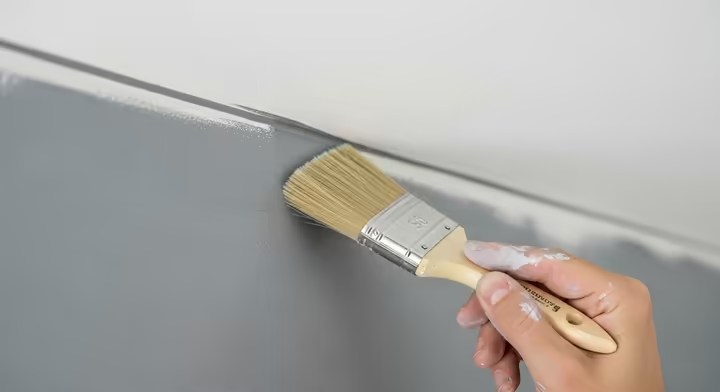
A well-executed cut-in is essential for a high-quality paint job. Clean, sharp divisions between colors and surfaces give a room a defined and orderly appearance. Poorly cut-in lines result in blurry, uneven edges that detract from the final look.
The Wet Edge Technique
When to Cut In
Standard practice is to cut in before rolling the main wall surfaces. This sequence allows you to first create a precise border with a brush. You can then bring the roller close to this brushed area, slightly overlapping to blend the two applications into a uniform finish.
Maintaining a Wet Edge
Maintaining a "wet edge" means applying roller paint while the adjacent cut-in paint is still wet. When wet paint from the roller overlaps the wet paint from the brush, they merge and dry into a single, seamless film. To achieve this, cut in one entire wall and then immediately roll that same wall before moving to the next.
Problems from a Dry Edge
Allowing the cut-in paint to dry completely before rolling causes several defects, most notably "picture framing" or "banding". This appears as a visible border where the cut-in area has a different sheen or a slightly darker shade than the rolled section. A dry edge also locks in textural inconsistencies, as the smoother brushed paint will contrast with the stippled texture of the rolled area.
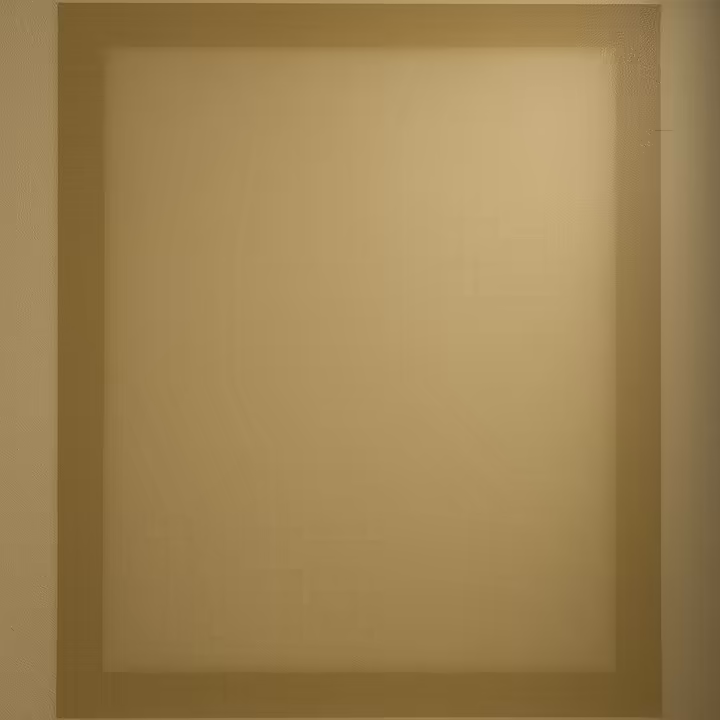
The wet edge rule has exceptions. Some premium, fast-drying paints may require the cut-in area to dry first, so check the manufacturer's instructions. Low-sheen paints like flat or eggshell are more forgiving of lap marks, as their matte surface diffuses light and hides minor variations.
Tools for Cutting In
The Angled Sash Brush
A high-quality angled sash brush is the best tool for cutting in. For water-based latex and acrylic paints, choose a brush with a blend of nylon and polyester filaments. Stiff bristles provide better control for creating straight lines.
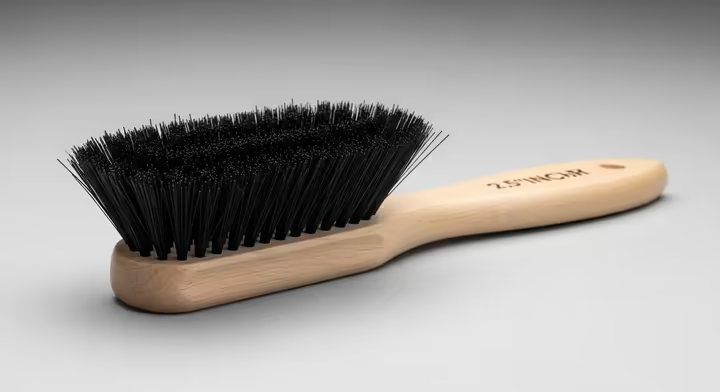
A 2.5-inch angled sash brush offers a good balance of paint-holding capacity and maneuverability for most jobs. More experienced painters may prefer a 3-inch brush for faster work on long, straight sections. Trusted brands include Purdy, Wooster, and Corona.
Edging Gadgets
Pad edgers and trim guides are marketed to simplify cutting in, but professionals generally find them ineffective. Common problems include guide wheels smearing paint, pads holding too little paint, and an inability to reach into tight corners. These tools also create a hard edge that can cause picture framing, unlike the soft, feathered edge a brush can produce for seamless blending.
Using Painter's Tape
High-quality painter's tape helps guarantee sharp lines, especially for complex areas or for those still developing a steady hand. Apply the tape and press its edge firmly with a flexible putty knife to create a tight seal and prevent paint from seeping underneath.
To prevent any paint from bleeding through, first seal the tape’s edge with the wall's existing base color or a clear, paintable caulk. Once this sealing coat is dry, you can apply the new wall color without it bleeding under the tape. For best results, remove the tape when the new paint is dry to the touch by pulling it slowly back on itself at a 45-degree angle.
| Tool | Primary Application | Required Skill Level | Professional Consensus | Common Failure Points |
|---|---|---|---|---|
| Angled Sash Brush | Freehand cutting of all edges, corners, and trim. | Beginner to Expert (mastery requires practice) | Universally recommended as the primary and superior tool. | Requires a steady hand; poor technique can lead to wavy lines or drips. |
| Pad Edger | Creating straight lines along ceilings and trim. | Beginner | Overwhelmingly negative; viewed as a gimmick. 24 | Smears paint, causes picture framing, cannot reach corners, poor paint coverage. 24 |
| Painter's Tape (with Sealing Technique) | Masking off surfaces to guarantee a perfect, crisp line. | Beginner | Recommended as a valuable aid for complex areas. | Bleed-under if not sealed properly; can pull fresh paint if removed when fully dry. 32 |
How to Cut In: A Step-by-Step Guide
Preparing Your Brush and Paint
Before first use, condition a new brush by wetting the bristles with the appropriate solvent, water for latex or mineral spirits for oil, then squeezing out the excess. Pour only one to two inches of paint into a separate "cut bucket" or small pail. This prevents overloading the brush and gives you better control.
Loading the Brush
Dip only the first one-third of the bristle length into the paint. Instead of wiping the excess paint on the rim of the pail, gently tap both sides of the brush against the inside walls. This removes drips while ensuring the brush remains evenly loaded for a long, smooth stroke.
Body Position and Movement
For maximum control, hold the brush like a pencil. Position your body for a clear view of the line and execute the stroke by moving your entire arm, not just your wrist. A steady, deliberate speed produces a straighter line than moving too slowly.
The Two-Stroke Method
First, apply a "reservoir" of paint with a single stroke about a half-inch away from the final line. For the second stroke, work from this reservoir without reloading the brush. Gently press the bristles so the tips fan out, then use the tips to guide a small bead of paint precisely along the edge.
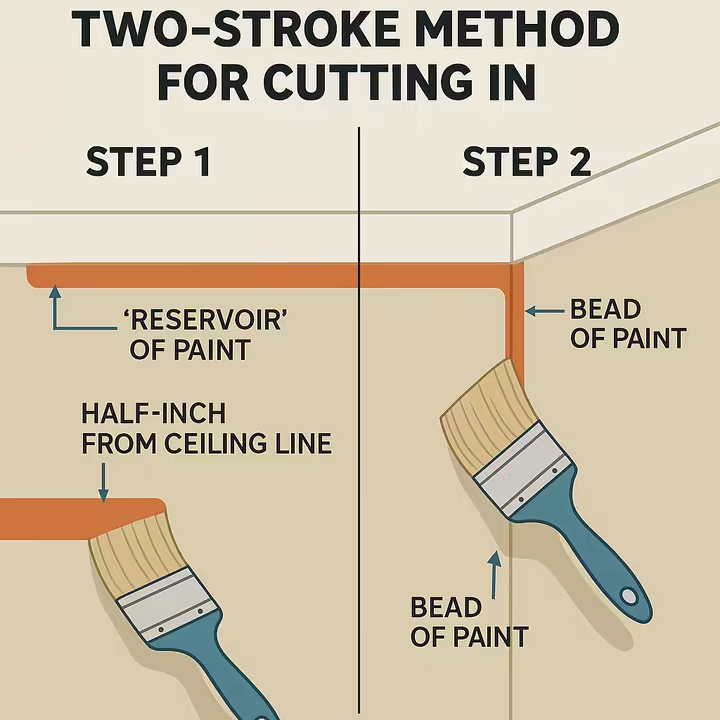
Feathering the Edge
To ensure a seamless blend with the rolled surface, feather the paint immediately after cutting the line. Lightly sweep the brush away from the line, extending the paint about 2 to 3 inches into the main wall area. This creates a tapered, feathered edge that allows the roller texture to blend in invisibly and prevents lap marks.
Troubleshooting Common Issues
Fixing Common Mistakes
Shaky lines are often caused by hesitation; use a confident, fluid arm motion. Drips and runs result from an overloaded brush, which can be fixed with proper loading technique. If drips dry, sand them smooth before repainting.
Cutting In on Textured Surfaces
Textured surfaces like popcorn ceilings make it difficult to paint a straight line. To overcome this, you can create a smooth path for the brush by gently scraping a channel with a putty knife or screwdriver. Alternatively, apply a thin bead of paintable caulk into the corner to fill the divots and create a smooth line to paint against.
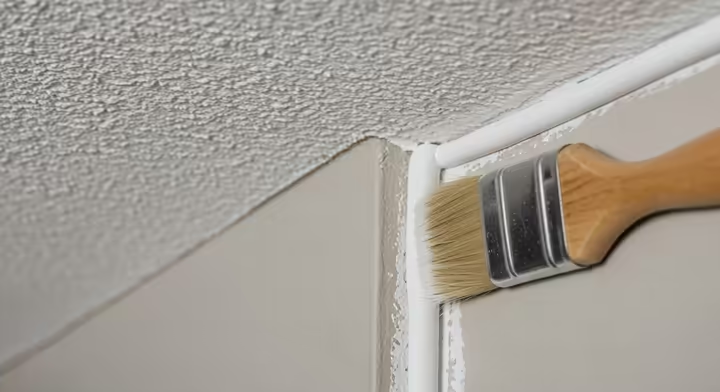
Using Paint Conditioners
Paint conditioners, or extenders, increase the paint's "open time," which is how long it remains wet and workable. This is useful in hot or dry conditions, as it makes maintaining a wet edge easier and helps prevent lap marks. These additives also improve the paint's flow, which reduces brush and roller marks.
Setup, Safety, and Cleanup
Workspace Preparation
Use drop cloths to protect floors, furniture, and fixtures from drips. Ensure the workspace is well-lit, using portable work lamps if necessary. Bright, direct light is essential for seeing the fine line you are painting.
Safety and Ergonomics
Maintain good posture to prevent back and neck strain, especially during long painting sessions. Use ladders correctly and safely. Take regular breaks to stretch and change positions to reduce muscle fatigue and maintain control.
Cleaning Your Brushes
Clean brushes immediately after use before the paint dries. For latex paints, rinse with warm water and use a painter's comb to work paint out from the bristles. For oil-based paints, clean first with mineral spirits, then wash with soap and water.
Storing Your Brushes
After cleaning, shake out excess water and reshape the bristles by hand. The best way to store a brush is in its original cardboard sleeve or "keeper," which holds the bristles in their correct shape. Hang brushes by the hole in the handle or lay them flat, never resting on their bristles.
Works cited
- What is Cutting In? - PaintAccess., https://www.paintaccess.com.au/blogs/company-news/what-is-cutting-in
- How to Cut in Paint - Harris Brushes, https://harrisbrushes.com/how-to-guides/how-to-cut-in-paint/
- How to Cut in Paint in a Room | Benjamin Moore, https://www.benjaminmoore.com/en-us/interior-exterior-paints-stains/how-to-advice/painting-101/cut-in-paint
- A handy breakdown of paint jargon | Tint, https://tintpaint.com.au/blog/a-handy-breakdown-of-paint-jargon
- How to Paint a Room | Sherwin-Williams, https://www.sherwin-williams.com/en-us/project-center/paint/how-to-paint-room
- Do You Let Cut In Dry Before Rolling? (Explained), https://letsupgradepainting.com/do-you-let-cut-in-dry-before-rolling/
- Hatbanding or Picture Framing Painting Problems. MyPerfectColor.com, https://www.myperfectcolor.com/Hatbanding-or-Picture-Framing/3575.htm
- How to Paint Interior Walls in 7 Easy Steps | Benjamin Moore, https://www.benjaminmoore.com/en-us/interior-exterior-paints-stains/how-to-advice/painting-101/painting-walls
- Cut then roll or Roll then Cut? : r/paint - Reddit, https://www.reddit.com/r/paint/comments/121qs4a/cut_then_roll_or_roll_then_cut/
- Cutting In: Top tips to get the perfect edge - Inspirations Paint, https://www.inspirationspaint.com.au/articleview/247/cutting-in-top-tips-to-get-the-perfect-edge
- The Best Tips for Cutting in Paint | Family Handyman, https://www.familyhandyman.com/list/the-best-tips-for-cutting-in-paint/
- www.myperfectcolor.com, https://www.myperfectcolor.com/Hatbanding-or-Picture-Framing/3575.htm#:~:text=%E2%80%9CHatbanding%E2%80%9D%20is%20the%20appearance%20of,hence%20the%20term%20picture%20framing.&text=Hatbanding%20occurs%20when%20you%20cut,a%20roller%20can't%20reach.
- How to Repair Picture-Framing on Painted Walls - ppgpaints.com, https://www.ppgpaints.com/pro/pro-painting-tips/how-to-fix-picture-framing-on-painted-wall
- Do you let your cut ins dry first before rolling? (Paint) : r/homeowners - Reddit, https://www.reddit.com/r/homeowners/comments/njxqs5/do_you_let_your_cut_ins_dry_first_before_rolling/
- Should I cut-in the whole room at once, or only the portion I'm working on?, https://diy.stackexchange.com/questions/38051/should-i-cut-in-the-whole-room-at-once-or-only-the-portion-im-working-on
- Purdy® Clearcut® Elite™ Glide™ Trim Brush | Purdy, https://www.purdy.com/en/products/brushes/clearcut-elite-glide.html
- How To Choose The Right Paintbrush - The Wooster Brush Company, https://www.woosterbrush.com/product-knowledge/how-to-choose-the-right-paintbrush/
- How to Choose the Right Paintbrush for Any Project | Purdy®, https://www.purdy.com/en/painting-resources/painting-faqs/how-to-choose-a-paintbrush.html
- How to Cut In Paint: 6 Essential Tips, https://ecospaints.net/blog/painting-guide-the-essential-tips-for-cutting-in-paint
- Professional painters: what is your favorite cut-in brush? I've always used a 3" Purdy angled Pro-Extra but I was wondering if there was something better out there. : r/HomeImprovement - Reddit, https://www.reddit.com/r/HomeImprovement/comments/81alko/professional_painters_what_is_your_favorite_cutin/
- Cut In Like A Pro - The Idaho Painter, https://www.idahopainter.com/cut-in-like-a-pro
- Purdy Paint Brushes (Like the XL Cub) Make Cutting in Easy - Family Handyman, https://www.familyhandyman.com/article/paint-brush-review-purdy-xl-cub-edging-cut-in/
- Best brush for cut ins? : r/paint - Reddit, https://www.reddit.com/r/paint/comments/1ilkh6v/best_brush_for_cut_ins/
- Paint Edger: A Pro's Review of Accubrush and Shur-Line (and more ..., https://www.bradthepainter.com/paint-edger-a-pros-review-of-accubrush-and-shur-line/
- Cut in paint with brush vs edge tool? : r/HomeImprovement - Reddit, https://www.reddit.com/r/HomeImprovement/comments/hp4lsr/cut_in_paint_with_brush_vs_edge_tool/
- Paint Edger Test and Review - Apartment Therapy, https://www.apartmenttherapy.com/viral-paint-edger-hack-review-36887103
- Should I be using a paint edger to 'cut in' when decorating? We get the verdict from professional decorators - Livingetc, https://www.livingetc.com/advice/should-i-use-a-paint-edger
- Painting 101/ clean cut lines - Fine Homebuilding, https://www.finehomebuilding.com/forum/painting-101-clean-cut-lines
- Cutting In Tips For Painting - The Paint Shed, https://www.thepaintshed.com/tips-advice/cutting-in-tips-for-painting
- Interior & Exterior DIY Painting Techniques - Sherwin-Williams, https://www.sherwin-williams.com/en-us/project-center/paint/diy-painting-techniques
- Paint like a Pro - How to paint a sharp line using masking tape - YouTube, https://www.youtube.com/watch?v=I40P7N9KeXg&pp=0gcJCfwAo7VqN5tD
- DIY tip - how to get sharp paint lines easily with blue tape. : r/DIY, https://www.reddit.com/r/DIY/comments/2p0r83/diy_tip_how_to_get_sharp_paint_lines_easily_with/
- How to Paint PERFECTLY Straight Lines On Textured Walls - MakeIt-LoveIt.com, https://makeit-loveit.com/paint-straight-lines-on-textured-walls
- How to Avoid 11 Painting Mistakes - Benjamin Moore, https://www.benjaminmoore.com/en-us/interior-exterior-paints-stains/how-to-advice/painting-101/avoid-11-painting-mistakes
- Cutting in Trim and Corners - Fine Homebuilding, https://www.finehomebuilding.com/project-guides/painting/cutting-in-trim-and-corners
- Cutting in paint: what's your method? - Fine Homebuilding, https://www.finehomebuilding.com/forum/cutting-in-paint-whats-your-method
- How do I master cutting in, and stop paying for the college education of the makers of painting tape? - Reddit, https://www.reddit.com/r/HomeImprovement/comments/8asnnt/how_do_i_master_cutting_in_and_stop_paying_for/
- How to Cut in Paint in a Room | Benjamin Moore - YouTube, https://www.youtube.com/watch?v=oqllhGh8eR0
- 10 Painting Tips for Cutting In - Room For Tuesday, https://roomfortuesday.com/10-painting-tips-for-cutting-in/
- Wall Painting Mistakes and How To Fix Them, https://www.jacobsenbros.com/wall-painting-mistakes-and-how-to-fix-them
- Paint Conditioners - A Full Guide - The Decorators Forum UK, https://www.thedecoratorsforum.com/paint-conditioners-a-full-guide/
- Cutting with textured walls : r/paint - Reddit, https://www.reddit.com/r/paint/comments/1fd0dmi/cutting_with_textured_walls/
- How to paint a straight line on a textured wall with contrasting colors. - YouTube, https://www.youtube.com/watch?v=n0mzhZuLe_c
- How to cut in on textured walls? Need Help! : r/paint - Reddit, https://www.reddit.com/r/paint/comments/164y340/how_to_cut_in_on_textured_walls_need_help/
- How can I get a straight line at the ceiling when painting a textured wall?, https://diy.stackexchange.com/questions/26528/how-can-i-get-a-straight-line-at-the-ceiling-when-painting-a-textured-wall
- Why use a paint conditioner? - Owatrol Direct, https://www.owatroldirect.co.uk/decorating/why-use-paint-conditioner/
- Floetrol: Eliminate Brush and Roller Marks - IGOE International, https://www.igoe.ie/floetrol-floetrol
- The Secret Ingredient That Makes Paint Go on So Much Smoother (Even On Furniture!) - Apartment Therapy, https://www.apartmenttherapy.com/how-to-use-paint-conditioner-37476596
- Flood Floetrol 1 qt. Clear Latex Paint Additive FLD6-04 - The Home Depot, https://www.homedepot.com/p/Flood-Floetrol-1-qt-Clear-Latex-Paint-Additive-FLD6-04/100198078
- How do you maintain good posture while painting? : r/minipainting - Reddit, https://www.reddit.com/r/minipainting/comments/1i36nn1/how_do_you_maintain_good_posture_while_painting/
- Ergonomics and Painting - Body Aches : r/minipainting - Reddit, https://www.reddit.com/r/minipainting/comments/1dxskwr/ergonomics_and_painting_body_aches/
- Purdy® | How to Clean Paint Brushes - YouTube, https://www.youtube.com/watch?v=iWJFcHl7PrA
- How to Clean and Store Your Art Brushes - Roben-Marie Smith, https://www.robenmarie.com/blog/how-to-clean-and-store-your-art-brushes
- Cleaning paint brushes - Reddit, https://www.reddit.com/r/paint/comments/1djista/cleaning_paint_brushes/
- How to Clean Paint Brushes - The Home Depot, https://www.homedepot.com/c/ah/how-to-clean-paint-brushes/9ba683603be9fa5395fab901f586e73a
- Tips for Cleaning and Storing All of Your Paint Tools - This Old House, https://www.thisoldhouse.com/painting/21015520/pros-tips-for-cleaning-and-storing-paint-tools
- Best Paint Brushes: Cut Better Lines and Go Faster! | Brad the Painter, https://www.bradthepainter.com/best-painting-brushes/